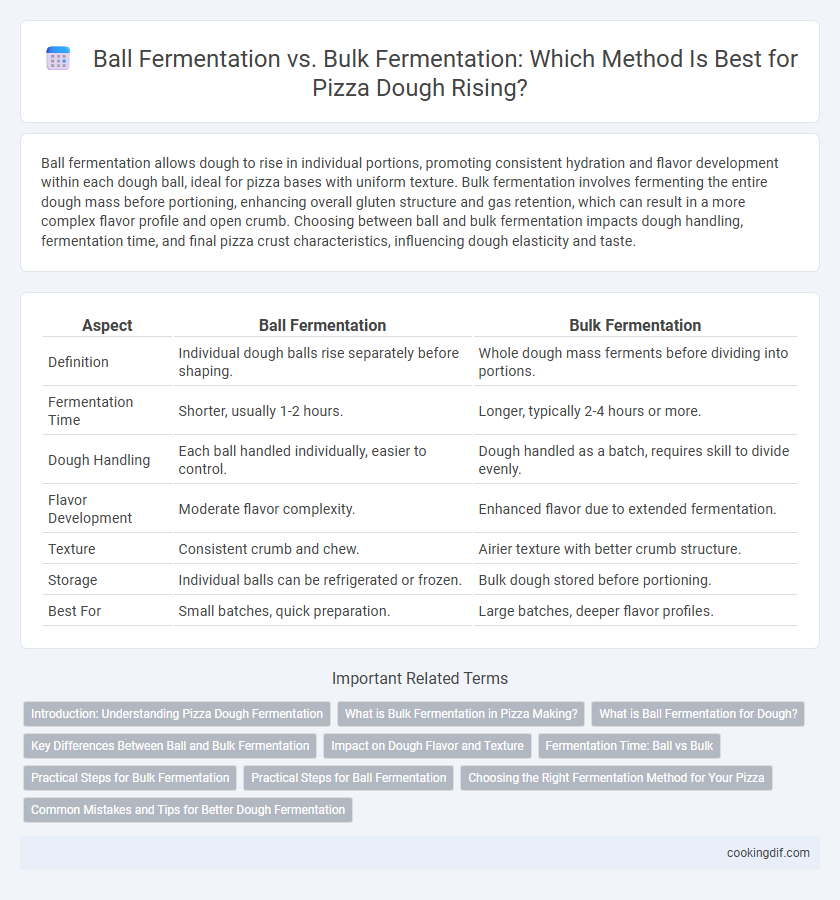Ball fermentation allows dough to rise in individual portions, promoting consistent hydration and flavor development within each dough ball, ideal for pizza bases with uniform texture. Bulk fermentation involves fermenting the entire dough mass before portioning, enhancing overall gluten structure and gas retention, which can result in a more complex flavor profile and open crumb. Choosing between ball and bulk fermentation impacts dough handling, fermentation time, and final pizza crust characteristics, influencing dough elasticity and taste.
Table of Comparison
| Aspect | Ball Fermentation | Bulk Fermentation |
|---|---|---|
| Definition | Individual dough balls rise separately before shaping. | Whole dough mass ferments before dividing into portions. |
| Fermentation Time | Shorter, usually 1-2 hours. | Longer, typically 2-4 hours or more. |
| Dough Handling | Each ball handled individually, easier to control. | Dough handled as a batch, requires skill to divide evenly. |
| Flavor Development | Moderate flavor complexity. | Enhanced flavor due to extended fermentation. |
| Texture | Consistent crumb and chew. | Airier texture with better crumb structure. |
| Storage | Individual balls can be refrigerated or frozen. | Bulk dough stored before portioning. |
| Best For | Small batches, quick preparation. | Large batches, deeper flavor profiles. |
Introduction: Understanding Pizza Dough Fermentation
Ball fermentation allows individual dough balls to ferment separately, promoting even gluten development and consistent texture throughout each pizza base. Bulk fermentation involves fermenting a large batch before dividing, which enhances yeast activity and flavor complexity but requires careful handling to maintain dough structure. Choosing between these methods impacts dough elasticity, rise time, and the final crust's chewiness and airiness.
What is Bulk Fermentation in Pizza Making?
Bulk fermentation in pizza making refers to the initial dough rising process where the entire batch of mixed ingredients ferments as one mass before portioning. This method enhances gluten development and flavor complexity as yeast and bacteria interact throughout the dough, producing carbon dioxide and organic acids. Compared to ball fermentation, bulk fermentation allows for better gas retention and more consistent texture in the final pizza crust.
What is Ball Fermentation for Dough?
Ball fermentation for pizza dough involves dividing the dough into individual portions or balls before the fermentation process begins, allowing each ball to rise independently. This technique enhances dough consistency, gluten development, and flavor by creating uniform fermentation conditions for each dough ball. Compared to bulk fermentation, ball fermentation helps achieve better control over dough hydration, texture, and final pizza crust quality.
Key Differences Between Ball and Bulk Fermentation
Ball fermentation involves dividing dough into individual portions before fermenting, allowing more consistent and uniform fermentation for each dough ball. Bulk fermentation occurs when the entire batch ferments together before dividing, promoting stronger gluten development and flavor complexity. Ball fermentation offers better portion control and easier handling, while bulk fermentation enhances dough extensibility and depth of flavor.
Impact on Dough Flavor and Texture
Ball fermentation enhances dough flavor and texture by allowing slow, uniform yeast fermentation within individually portioned dough balls, resulting in a more complex, slightly tangy taste and a chewier, airier crust. Bulk fermentation promotes rapid yeast activity across the entire dough mass, creating a milder flavor profile and a denser, less elastic texture due to faster gas production and less controlled gluten development. Choosing ball fermentation is key for artisan pizza aiming for depth of flavor and an open crumb structure.
Fermentation Time: Ball vs Bulk
Ball fermentation requires longer fermentation times, typically ranging from 12 to 48 hours, allowing dough balls to develop a complex flavor and ideal texture through slow, controlled yeast activity. Bulk fermentation is shorter, often between 1 to 3 hours, during which the entire dough mass ferments before being divided into individual portions, balancing time efficiency with moderate flavor development. Optimal fermentation time depends on desired dough characteristics, with longer ball fermentation enhancing aroma and crust structure, while bulk fermentation prioritizes speed and uniform rise.
Practical Steps for Bulk Fermentation
Bulk fermentation involves allowing the entire dough mass to rise after mixing, promoting even yeast activity and gluten development. Practical steps include transferring the dough to a lightly oiled container, covering it with plastic wrap or a damp cloth, and letting it rest at a controlled temperature between 75-80degF (24-27degC) for 1 to 3 hours until it doubles in size. This method enhances dough flavor complexity and texture, making it ideal for Neapolitan-style pizzas.
Practical Steps for Ball Fermentation
Ball fermentation involves dividing the dough into individual portions immediately after mixing, allowing each dough ball to ferment separately in its own container. This method improves dough handling by ensuring consistent fermentation, easier portion control, and enhanced flavor development within a controlled environment. Practical steps include shaping the dough into uniform balls, lightly oiling each ball to prevent drying, placing them in covered containers or trays, and fermenting at a controlled temperature for optimal yeast activity.
Choosing the Right Fermentation Method for Your Pizza
Ball fermentation offers consistent dough size and shape control, making it ideal for precise portioning and uniform pizza bases. Bulk fermentation promotes improved gluten development and flavor complexity due to longer resting times before dividing the dough. Selecting the right fermentation method depends on whether you prioritize dough handling efficiency or enhanced taste and texture in your pizza creations.
Common Mistakes and Tips for Better Dough Fermentation
Ball fermentation often leads to uneven dough fermentation due to inconsistent temperature and humidity control, resulting in poor texture and flavor development. Bulk fermentation mistakes include over-proofing or under-proofing dough, which can cause dense or overly airy crusts, so monitoring fermentation time and environment is crucial. Use a kitchen thermometer to maintain optimal fermentation temperature around 75-78degF and incorporate timely folding during bulk fermentation to improve gluten structure and dough strength.
Ball fermentation vs Bulk fermentation for dough rising Infographic

 cookingdif.com
cookingdif.com